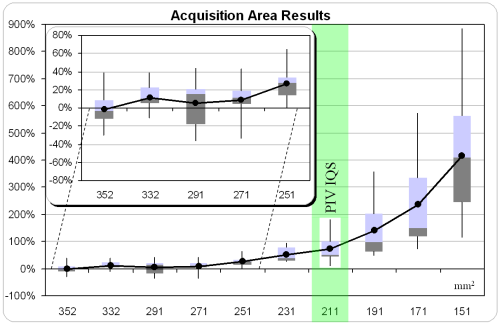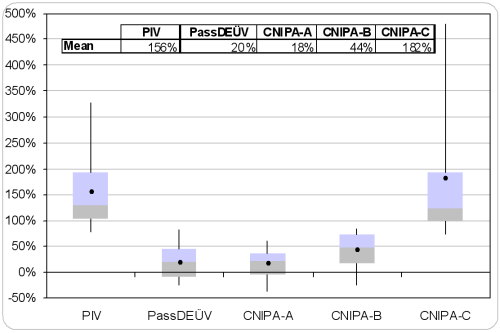|

Home

People

Research

Publications

Resources

Related Links
|
|
Scanner QualityLive-scan fingerprint acquisition is a widespread technique since several years. The quality of the sensor used to acquire the fingerprint images is a fundamental feature in the development of a new recognition system. For this reason the certification of these devices is a very important topic.
To this purpose, the FBI established an IAFIS Image Quality Specification (IQS) in order to define the quantitative image quality requirements for IAFIS fingerprint scanners and more recently a new IQS which defines the quantitative image quality requirements for single-fingerprint capture devices suitable for application in the Personal Identity Verification (PIV) program. In both specifications, the “quality” is defined as “fidelity” of the scanner in reproducing the original fingerprint pattern, and it is hence quantified by measures traditionally used for vision, acquisition and printing systems: geometric accuracy, gray level dynamic range, SNR, MTF, etc. Operational Quality of a Fingerprint Scanner
In order to evaluate the real effects of the various quality parameters on automated fingerprint recognition accuracy, the term “operational quality” has been introduced and a systematic experimentation following a well defined test approach has been carried out. - By “operational quality” we mean the ability of a fingerprint scanner to acquire images that maximize the accuracy of automated recognition algorithms.
- For each quality parameter, the output of scanners compliant with gradually-relaxed requirements has been simulated by modifying the images of a fingerprint database (FVC2006 DB2) with appropriate transformations, then, given a set of recognition algorithms (ten of FVC2006 best performing algorithms on DB2 have been selected), we measured the recognition accuracy of each algorithm on each database. Finally the dependency between the requirements and the accuracy has been measured by considering, for each algorithm and for each requirement, the relative EER difference. In other words, the performance drop has been measured starting from a fingerprint database and then deteriorating the images to simulate scanners compliant to a less-stringent specification. More details are available in these slides.

 Analysis of the preliminary results
The following considerations can be made: - In IAFIS and other large scale systems, where the images may be examined by forensic experts it is clearly correct to define the scanner quality as fidelity to reproduce the original signal. In fact human experts’ fingerprint comparison heavily relies on very fine details such as pores, incipient ridges, etc. for which the fidelity to the original signal is very important.
- In totally-automated biometric systems where: i) the images are stored but used only for automated comparisons, or ii) only fingerprint templates are stored; the definition of “operational quality” appears to be more important than the absolute fidelity to the original signal because the choice of a particular scanner should be driven by the desired performance.
- The most critical quality parameters are the Acquisition area and the Output resolution, which, at the PIV IQS minimum requirements, caused an average performance drop of 73% and 20%, respectively. On the other hand, other quality parameters (Signal to Noise Ratio, and Dynamic Range) do not seem to affect much the automated recognition performance.
New image quality specifications
In cooperation with the Italian National Center for ICT in the public administration (CNIPA), starting from the preliminary results obtained on Operational Quality we proposed three new sets of specifications targeted to different type of applications:- CNIPA-A is conceived for: i) enrolment in large-scale applications where device interoperability is crucial (e.g. passports, national identity card); ii) identity verification in large-scale applications where the enrolment has been performed with an IAFIS IQS or CNIPA-A complaint scanners (e.g. passport or visa verification);
- CNIPA-B is conceived for: i) enrolment and verification in medium-scale projects (e.g. intra-organization projects); ii) identity verification in large-scale applications where the enrolment has been performed with CNIPA-A scanners (e.g. national identity card verification);
- CNIPA-C is conceived for enrolment and verification in small-scale applications, where typically users are authenticated on the same device (e.g. logical and physical security in small organizations).
More details are available in these slides.
These new IQS are currently being recommended by the Italian National Center for ICT in the public administration; in particular the specification A is the point of reference for the Italian biometric passport and identity card.
A comparison between the new specifications, PIV and German (PassDEÜV) IQS has been carried out simulating fingerprint images acquired by hypothetical scanners compliant with each IQS applying sequentially to the original database (FVC2006 DB2) appropriate transformations.

Then, the dependency between the specifications and the recognition accuracy has been measured:

Conclusions
According to the experimental results, we can conclude that the three proposed specifications are well suited for the applications they are targeted to. In particular:- CNIPA-A specification is able to guarantee the best performance among the five IQS reviewed, thanks to the higher acquisition area, which proved to be the most important parameter;
- CNIPA-B specification is able to guarantee an accuracy that is clearly better than PIV and not too far from PassDEÜV; on the other hand, the cost of a device compliant to CNIPA-B would be definitely lower than that of one compliant to PassDEÜV, thanks to the less demanding requirements on five parameters;
- CNIPA-C specification can guarantee an accuracy similar to PIV but, also in this case, the cost of a device compliant to CNIPA-C would be definitely lower than the cost of PIV-compliant devices.
Bibliography(Click here if you are interested in any of the publications below) | D. Maltoni, D. Maio, A.K. Jain and J. Feng, Handbook of Fingerprint Recognition (Third Edition), Springer Nature, 2022. |  | M. Ferrara, Biometric Fingerprint Recognition Systems, Lambert Academic Publishing, 2010. |  | R. Cappelli, M. Ferrara and D. Maltoni, "On the Operational Quality of Fingerprint Scanners", IEEE Transactions on Information Forensics and Security, vol.3, no.2, pp.192-202, June 2008.  Abstract Abstract |  | A. Alessandroni, R. Cappelli, M. Ferrara and D. Maltoni, "Definition of Fingerprint Scanner Image Quality Specifications by Operational Quality", in proceedings European Workshop on Biometrics and Identity Management (BIOID 2008), Roskilde, Denmark, pp.29-35, May 2008.  Abstract Abstract |  | M. Ferrara and D. Maltoni, "On the Operational Quality of Fingerprint Scanners", in proceedings Second NIST Biometric Quality Workshop, Gaithersburg, Maryland, November 2007. |  | M. Ferrara, A. Franco and D. Maltoni, "Fingerprint scanner focusing estimation by Top Sharpening Index", in proceedings 14th International Conference on Image Analysis and Processing (ICIAP07), Modena, Italy, pp.223-228, September 2007.  Abstract Abstract |  | M. Ferrara, A. Franco and D. Maltoni, "Estimating Image Focusing in Fingerprint Scanners", in proceedings Workshop on Automatic Identification Advances Technologies (AutoID07), Alghero, Italy, pp.30-34, June 2007.  Abstract Abstract |  | R. Cappelli, M. Ferrara and D. Maltoni, "The Quality of Fingerprint Scanners and Its Impact on the Accuracy of Fingerprint Recognition Algorithms", in proceedings Multimedia Content Representation, Classification and Security (MRCS2006), Istanbul, pp.10-16, September 2006.  Abstract Abstract |  | R. Cappelli, M. Ferrara and D. Maltoni, "The Quality of Fingerprint Scanners and its Impact on the Accuracy of Fingerprint Recognition Algorithms", in proceedings First NIST Biometric Quality Workshop, Gaithersburg, Maryland, March 2006. |
|





